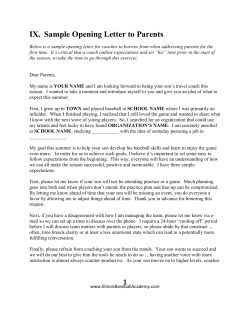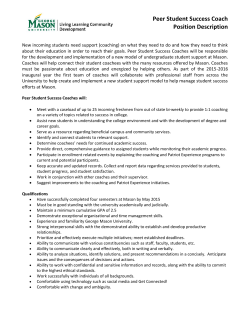
AUSTRALIAN TENNIS MAGAZINE | August 2013
Aussie Coaches: on tour & in demand There is no magic about Australia’s famous tennis coaches. Hard work and honesty are the keys to their success. Harry Hopman might have started it, but Tony Roche, John Newcombe, Bob Carmichael and Bob Brett are just a few who have passed on the traditions that make Australia tennis-proud – at home and away. By Robert Davis W hen Jo-Wilfried Tsonga faced Victor Troicki at this year’s French Open in the round of 16, two Australians were coaching both players, Roger Rasheed and Jack Reader respectively. No mere coincidence. Several Australians were coaching foreign players in both the men’s and women’s events at Roland Garros. Players wanting to go from good to great have for decades been making the long trip Down Under in search of tennis coaches. From Ivan Lendl and Roger Federer seeking out Tony Roche, to Boris Becker and Goran Ivanisevic signing up with Bob Brett. Andre Agassi, looking for a boost late in his career, came calling on Darren Cahill. And Rohan Goetzke not only guided Richard Krajicek to the Wimbledon title but also became the technical director for the Dutch tennis association. One has to wonder: what is it about Australia’s coaches that has them in such demand? 64 Australian Tennis Magazine | August 2013 Never be a yes man. That was the advice Harry Hopman gave to young promising coaches. For Hopman, mastermind of Australia’s Davis Cup dynasty in the 1950s and 1960s, telling the player what he needed to hear and not just what he wanted to hear was priority number one. “We were fortunate enough to have Harry Hopman, who had the vision of what was required to be a champion,” says Bob Brett, who in addition to coaching ATP stars has also served as a consultant the national federations of Canada and Japan. “Players and coaches benefited from Hopman’s methods and developed and passed their knowledge onto those who followed,” adds Brett. “Many of his players became coaches. Also we were fortunate that we had Frank Sedgman to look up to.” Lendl has made no secret of how much respect he has for his former coach Tony Roche. “Tony and I never argued,” remembers Lendl. “I wanted to know how to get better, Tony told me what he thought and I respected what he said. End of story.” “If you were going to have to coach, Ivan (Lendl) was the guy,” says Roche. “He was extremely professional. He wanted to do the hard work, which was perfect for me. Ivan did not want any shortcuts. Ivan wanted to know the truth and our relationship was based on honesty. Not once in those seven or eight years was there a problem. I think that a good coach has to have the respect of the player. If you don’t have that then you are not going to get good results.” Asked where Australia’s coaching expertise originated, Roche does not hesitate. “I think it started with Harry Hopman. A bit like our production line of players, all the great champions we have had over the years, it has to start somewhere. Frank Sedgman (leader of the post-war gold-rush of Australian winners) was a player who believed in hard work and being fitter and stronger than the opposition. Hopman was big on discipline both on and off the court. A lot of top Aussie coaches have one way or another been influenced by Harry Hopman. “Also, I was fortunate to have Dinny Pails as a mentor. He took an interest in me when I started out and was a big influence on me. I think it is important to pass our traditions down the line to our upcoming coaches.” Which is exactly what is happening. Though Tennis Australia and the Australian Institute of Sport offer a wide range of coaching education programs, it seems the most proven and effective method over the years has been oldfashioned mentoring. A prime example is Luke Bourgeois. When he decided to stop playing and start coaching he had plenty of experience to draw upon from his time with some of Australia’s finest coaches. “I had the good fortune to work with many great coaches over my playing career, beginning with Kim Warwick and Brent Larkham to Tony Roche,” acknowledges Bourgeois. “Warwick’s ability to instill confidence and belief in my abilities had the greatest impact on my game. Kim gave me so much confidence with the faith he had that I would succeed [in] becoming a professional player. Brent Larkham was also instrumental in my development. For me, Brent’s strengths were his ability to maximise my game style through specific types of training and the strategy required to play that style. “Tony Roche had a huge impact on me. I’m extremely fortunate [that] over 13 years I was able to spend countless hours on court with Rochey. His methods are simple but so effective, which is to train at the highest possible intensity for a very long period of time. It is the understanding that there are no short-cuts and no easy options. It is just about getting out there and toughing it out, constantly working towards developing as an athlete, ball-striker and all-round competitor. The respect he commands is second to none, and to have him in your corner, hearing his infamous grunt, inspires.” Bourgeois remembers well one extreme training block with Roche in 2005. “We were in Dubai helping Roger Federer prepare for the US hardcourt season,” he recounts. “It was 10 days A lot of top Aussie coaches have one way or another been influenced by Harry Hopman. of the most brutal training you could imagine. On one particular day, we had a five-hour session to prepare for the bestof-five set matches at the U.S. Open, in often hot and humid conditions. “The thermometer we took out on court maxed out at 60 degrees Celsius so we still don’t know how hot it was on court that day but I’ve never had so much equipment Australian Tennis Magazine | August 2013 65 spread out on a court. We had multiple changes of shoes as they became so drenched with sweat that we could see our foot prints by the splash marks. We had about a dozen racquets lined up, either letting the handles dry out from sweat or they were the next in line to be used.” It is anecdotes like this that Bourgeois passes on to his current players, and so the message of hard work, even for the most talented of tennis champions, lives “I think what makes Australian coaches successful abroad is their honesty.” on. However, as professional tennis has evolved, so has the role between coach and player. As players are often the employer these days (unlike in Hopman’s time), they have more leverage over coaches. “Finding the right way to communicate with today’s generation of players is not as easy as in the past,” says Jack Reader, who previously worked with young gun Alexandr Dolgopolov. “For most coaches, the player is the one paying the coach’s salary. So you have to pick and choose your moments wisely. The challenge of the job is to get the player to improve, and if you don’t take time to understand your player you might lose him before you get started.” “I think what makes Australian coaches successful abroad is their honesty,” says 66 Australian Tennis Magazine | August 2013 Darren Tandy, coach of Dmitry Tursunov. “In general, they tell the players what is required to be successful.” And that is exactly what the doubles team of Aisam Qureshi and Jean-Julian Rojer wanted from Pat Cash when they asked him for help before this year’s Wimbledon. Immediately, Cash asked Mark Woodforde to join him in a practice session at the Hurlingham Club with Qureshi and Rojer. It wasn’t long before the two Aussie legends were putting the boys through their paces. As Woodforde explained the finer points of doubles, Cash stressed the need for greater intensity and quality in the training session. “Getting an opportunity to learn from two of the game’s greats has been really special,” says Rojer. “Anything that Woodforde says about doubles you have to listen to and try to follow his advice.“ “Pat (Cash) knows not only what to say, but when to say it,” adds Qureshi. “Prize money has increased so much and given the game of tennis the opportunity to have private coaches,” says Darren Cahill. “My entire career was with Bob Carmichael, and I had to share him with three and four other players. He instilled in me a great work ethic. I really feel that we have been taught well by the generation before us. We have a real passion for coaching.” Tennis is played a bit differently today; players stay back more and hit with heavier topspin than in Hopman’s day. And technological advances in sport science and video analysis like Dartfish have helped coaches become more specific. While a good understanding of technique and training methods are essential for any coach, the common denominator of Aussie tennis coaching excellence is the tradition of being honest with the player, hard work and mentoring the next generation. It is safe to say that Harry Hopman would be most proud of how Australian coaches have honoured his legacy by continuing to carry on with his message of hard work and never being a Yes Man. n
© Copyright 2025









